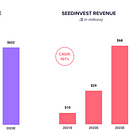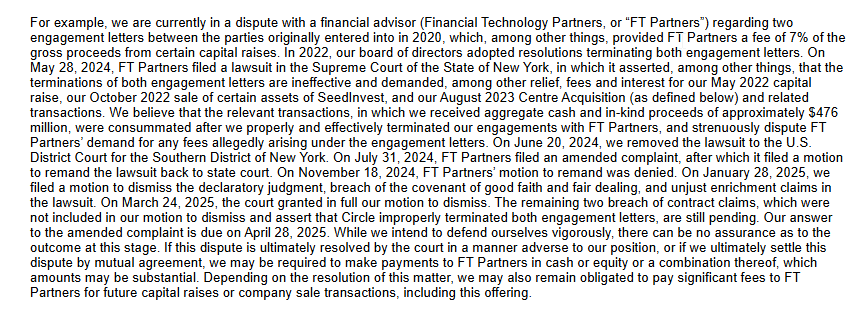Analysis: Our Circle IPO Primer, $1.6B revenue reaching for $10B valuation
Interest rates all the way down
Hi Fintech Architects —
This is a good one. Today we are diving into the following topics:
Summary: We examine Circle’s IPO financials amid a broader resurgence in fintech public listings. Circle generated $1.6B in revenue and $157M in net income in 2024, primarily from interest earned on USDC reserves, with performance closely tracking interest rate movements. Circle operates with a risk-averse, compliant model, but faces growing revenue compression from rising distribution costs and competitive pressure to pass on yield to users. Tether, by contrast, is generating significantly more revenue ($14B in 2024) by taking on more portfolio risk. While Circle may pursue a $10B valuation, falling margins, rising costs, and unclear derivative-related losses highlight the challenges of sustaining profitability in a maturing, highly competitive stablecoin market.
Topics: Circle, Coinbase, Tether, BlackRock, BNY Mellon, SoFi, Robinhood, Wise, Dave, MoneyLion, SeedInvest, Voyager, FT Partners, Betterment, Fidelity, Chase
To support this writing and access our full archive of newsletters, analyses, and guides to building in the Fintech & DeFi industries, see the options below. It’s only $4 per week — less if you get an annual subscription.
Long Take
On the Road Again
It’s Fintech IPO season.
Finally.
The recent class of IPOs has not performed all that well. But there are structural reasons why these companies have to come to market. Private investors, especially smaller funds, cannot raise new money until they return money from prior funds to their investors. This creates an explosive pressure to sell companies into the market. And the current market moment might be good enough.
The last time we saw so many private Fintech and Crypto companies showing off their financials was during the 2021 SPAC boom. SoFi, Robinhood, Coinbase, Circle, Wise, Dave, MoneyLion all had paths to the public market. Some took the path. Others, like Circle, canceled out of their process to avoid the bloodbath that was the 2022 SPAC bust.
Here is the entire Shakespearean drama, if you want to read about the show from the beginning.
It didn’t end super well.
For Circle, it ended with a lawsuit from FT Partners, their investment banker, wanting a 7% fee on a $500MM raise, or about $35MM in legal exposure.
Circle has since focused its business on the success of the USDC stablecoin, which continues to have geopolitical importance for the United States. It has divested itself of crowdfunding platform SeedInvest in 2022, leaving behind crowdfunding and equity brokerage (having sold an exchange to Voyager previously), and leaning all the way into the stablecoin bet. This has paid off.
The main reason is has paid off has more to do with macroeconomics than anything else. But life is chaos. Below is the interest rate chart over the last 5 years.
This is the Circle business in a nutshell.
It is, in fact, the main reason for the rebound of the entire Fintech industry in the last few years, and why neobanks and neobrokers have been able to scrape together profitability.
On top of that, Circle has survived multiple crises, strengthened its banking partnerships, and continues to be indispensable to portions of the onchain finance markets. It has positive performance alpha in an industry that is bound to blow up from volatility, and for that we are grateful.
Let’s take a look at the economics.
Performance
The company generated $1.6 billion of revenue for 2024, with a net income of $157MM and an adjusted EBITDA of $284MM.
This is a good, chunky performance on first glance.
A naive 5-10x multiple on this revenue would get us to a $7-12B valuation for this business. The main crypto comparable, Coinbase, trades at $46B on $6B of revenue, or an 8x multiple. For good old banks, however, P/E ratios float around 12x, which would imply around a $2B valuation — far less than the aspiration.
Below we dig into the quality of the revenues and the profitability of the business.
As an aside, you should be able to see how the shape of the revenue is exactly the shape of the interest curve above.
So how do we segment revenue? In the first chart, we look at what interest is earned on Circle’s USDC reserve, which is essentially the rate of return they can get on their USDC supply, and at “other revenue”, which is largely treasury services. Nearly all of what matters relates to the management of deposits. This is not a diversified bet, like Coinbase, Robinhood, or SoFi. It is an interest-rate sensitive asset pool with a technological adoption curve behind it.
In the second chart, we look at the transaction costs that Circle pays to exchanges in order to be included as a key asset — with the lion’s share of that being Coinbase. You can see that distribution hurts, and Circle’s ability to drive good economics with scale is under quite a bit of pressure. They are making less money, not more. In a later section we will touch on just how much Coinbase is getting, having been involved in the founding and distribution of Circle since the beginning.
So how does Circle make money from USDC?
Like a bank or a money market fund, it receives dollars and invests them in a portfolio of nearly risk-free investments. Then, it has a liability to their depositors, meaning that people should be able to redeem their USDC for a dollar. A bank run is unlikely because the entire thing is collateralized and does not participate in the reserve banking shenanigans of letting people have mortgages and credit cards. That is, unless all of its underlying custodians happen to be the target of a government crack down — something that did indeed happen before.
Here is the portfolio as of 2024 and 2023.







